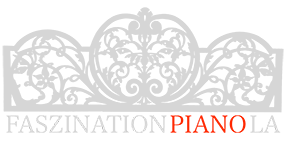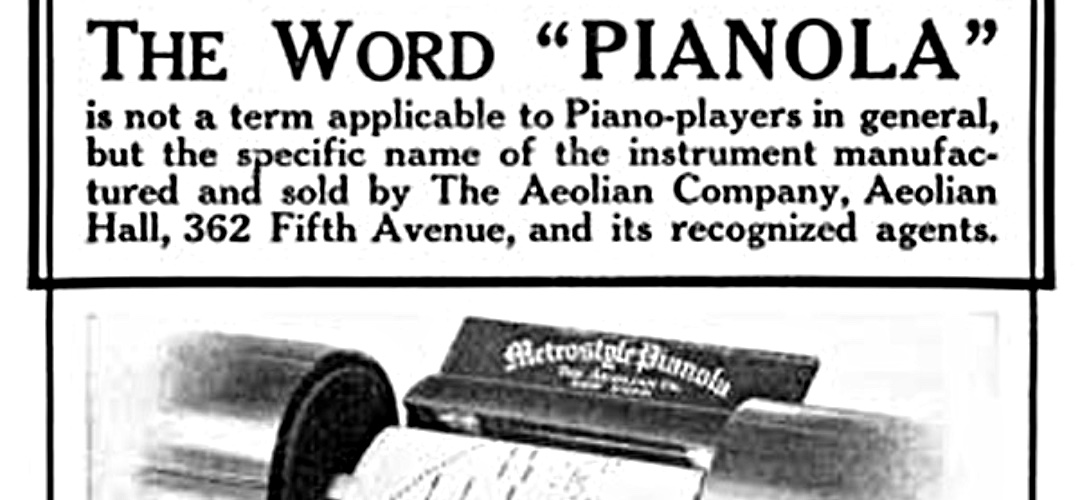The name "Pianola" is actually a product name for the self-playing mechanism built around 1895 by Edwin Votey, which was marketed very successfully worldwide from 1897 by the Aeolian Company New York. This product name has been retained to this day, even more so than the product name "Phonola" introduced by Hupfeld in 1902 as a designation for the self-playing upright and grand pianos as a whole.
Many manufacturers then called their own instruments "Pianola grand" or "Pianola upright", so that the Aeolian Company always pointed out that the real Pianola comes from their company. Correctly it is called "the" Pianola or "the" Phonola, because the word endings should have quite consciously a female form.
Other manufacturers have also registered their own word creations - often in conjunction with the manufacturer's name - as trademarks for their self-playing instruments, such as Pleyela, Ibachiola, Orphobella, Phonobella, Pianella, Playola, Symphoniola, etc. - none of these, however, has become as widely accepted as the term "pianola" coined by Edwin Votey.
MECHANICAL PIANO
The term "mechanical piano" was advertised by Hupfeld in the Zeitschrift für Instrumentenbau in 1893. A press roller was moved by means of a crank, which then scanned the tones in the piano and made them sound. The faster the crank was moved, the louder and faster the piece of music became. Although already impressive in the sense of mechanical implementation, the sound remained very mechanical and could hardly be compared with natural piano playing.
ELECTRIC PIANO
The term "electric piano" is also widespread in the German-speaking world - although the vast majority of self-playing pianos without an electric motor were only operated with pedals. And these instruments are only "self-playing" if they are actually electrically operated pianos - otherwise the pianist is still needed, who produces music via the pedals and levers of the pianola by means of the music roll.
Even though different self-playing piano mechanisms existed much earlier in the 19th century in e.g. France, Germany and the USA, the American Aeolian Company certainly made the decisive breakthrough with the Pianola - and Hupfeld made it shortly afterwards in Germany with the Phonola. Hupfeld made unprecedented use of the possibilities offered by advertising and the media of the time. Not only in the Zeitschrift für Instrumentenbau did Hupfeld constantly advertise for the Phonola and specifically also against the Pianola in the most prominent places.
The history of self-playing or so-called mechanical musical instruments goes back many centuries. Before the self-playing pianos, it was mainly the music boxes and music boxes that brought mechanical music into the mostly prosperous home. It has always been the mixture of inventive talent, fascination for technology and the joy of enjoying music that has given rise to so many different mechanical instruments.
In the late 19th and early 20th century, a time when there were no satisfactory sound carriers or broadcasting stations for the enjoyment of music at home, in cafés, bars or restaurants, a time when music was still a natural part of family culture, these self-playing pianos and grand pianos had their heyday. The great success of the pianolas in the period from 1895 to 1935, shortly before the First World War, when the highest annual sales were reached, was mainly due to the fact that piano music had become the dominant form of music in the households and piano music belonged in every "good house" - even in those where no great talents in piano playing were to be found. By means of the pianolas, piano music could also be produced and enjoyed there at a higher level. Since at the same time the social life in countless cafés and dance halls was also strongly established, self-playing pianos were equipped with additional instruments such as percussion, flutes etc. and sold very successfully as orchestrions. The result was true miracles of technology, which - much to the chagrin of the many small orchestras - were widely distributed.
The suppliers were very inventive in marketing these combined instruments. Since many households already owned normal hand pianos and grand pianos, they had to succeed in convincing customers to switch. To this end, buy-back campaigns, free roll offers, subscriptions, etc. were offered. A lucrative follow-up business for the piano dealers was the continuous sale of music rolls. The latest titles were always advertised, current songs, marches, hits and new recordings of the most popular classical titles. An average collection of a piano owner contained about 50-70 titles. Not only the manufacturers of pianolas but also other companies have concentrated on this interesting business. Scores were also available in libraries for a loan fee. Not only new titles were acquired, but also replacements for scrolls that were played so often that they could no longer be used reliably.
PIANO ROLL TYPES
There were basically two different pianola and role philosophies - the arranged roles, which only recorded the sequence of notes on the rolls of music and left the entire emphasis and tempo control to the pianola player. In contrast, the reproduction rolls, which were recordings of a pianist's playing and could be reproduced quasi 1:1. An interim solution are the so-called artist roles, which contained the playing of a pianist, but left the emphasis and tempo control to the pianist.
As quickly as the rise of these pianolas occurred, their era also ended rapidly. It took a long time for the record to reach a quality that allowed music to be enjoyed without disturbing background noise, but then these phonographs spread in large numbers to the wealthy households that had previously preferred pianolas. In the mid-1920s, radio broadcasting also spread rapidly, displacing pianolas even faster. Resourceful manufacturers tried to counter this by offering pianolas with built-in phonographs and/or radios - but these attempts at survival were not successful. The pianola industry, which had recovered poorly from the First World War - and had suffered considerable damage due to the economic crisis at the end of the 1920s - collapsed completely in the early 1930s. Due L. Hupfeld AG, one of the world's largest manufacturers of mechanical musical instruments with over 2000 employees, had to almost completely stop production in 1934.
DIGITAL PIANOLA SYSTEMS
Today, digital computer-based self-playing mechanisms are offered in upright and grand pianos - but even these are now a rare marginal phenomenon. Steinway Spirio and Yamaha's PianoDisk are examples. Thanks to the possibilities of worldwide networking, data - what used to be the music roll - can now be downloaded and shared at will. Due to the restrictions imposed by the Corona Pandemic, the Freiburg University of Applied Sciences has transferred and made possible examinations using the Yamaha Disklavier technology over thousands of kilometres from piano to piano - here the report in the ZDF heute journal of 13.06.2020.
Just like the attempt in the 1930s to combine pianola, gramophone and radio in one piano - today's self-playing instruments are real entertainment all-rounders. Our Galaxy Diamond Acrylic Concert Grand Piano from 2009 with web-based Pianodisc system can be controlled via Ipod/Ipad, has a Bose sound system, a Pianodisc self-player, a lighting system etc. etc. So today you can be connected to live concerts anywhere in the world and experience the playing of e.g. Elton John, Norah Jones, etc. on a video screen - and the grand piano plays the original playing of the pianist live on the grand piano, transmitted via the internet. If Hupfeld, Welte and the others had had these possibilities, they would certainly have made the same or more of the possibilities.
Many millions of self-playing pianos/ grand pianos and scrolls were produced between 1900-1930, of which only a few copies have survived, despite the fact that more than 100 years have passed and the historical turmoil. It is mostly museums and passionate collectors who own these unusual self-playing instruments today. In the meantime, however, fortunately, there are more and more people who are fascinated by the charm of the more than 100-year-old mechanical marvels and make music with a pianola. And then, as now, this kind of music-making can trigger great enthusiasm and joy in everyone involved.


